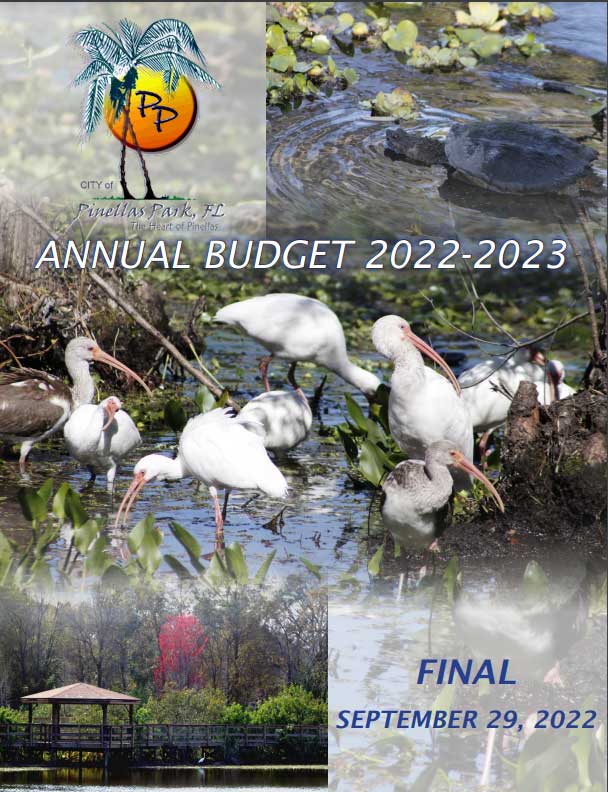The City of Pinellas Park, Florida, faces several significant infrastructure challenges that impact the daily lives of its residents. The aging water and sewer systems are among the most pressing issues, which require costly repairs and upgrades to maintain safe and reliable service. Additionally, the city’s transportation networks require modernization and expansion to reduce congestion and improve safety, including road upgrades and public transit options. Pinellas Park also needs to invest in affordable housing developments to meet the needs of its growing population. Addressing these challenges will require collaboration and investment from local and state officials and private sector stakeholders.
City of Pinellas Park, Florida
Population (Year): 53090 (2020)

Sample Highlights from the Capital Improvement Plan
Project ID
Project Title
Project Start Year
Project Description
Project Spend Total
Page Ref
Project Satus
465527
Pavement Evaluation – Citywide
2025
The inspection and grading of the roadway network within the City of Pinellas Park is on a 3 year rotating basis. Pavement Condition Index scores are used to assist and guide management of transportation assets and future CIPs.
60000
276
Ongoing
465545
Sidewalk and Accessibility Ramp Repair and Replacement ADA Program
2023
Repair and replace existing sidewalks to meet ADA standards for accessible design.
825000
276
Not Started
466506
Pinellas Park Housing Rehabilitation Program
2024
Rehabilitation of owneroccupied single family homes for low to moderate-income persons. Account No
400000
279
Not Started
466534
Multi Level Parking Facilty
2024
Construct a multi level parking facilty with approximately 500 parking spaces and elevators near 58th street and Park Blvd. Twenty year loan from general fund beginning 10/1/2023 with semi annual repayments at 3% interest.
15000000
279
Ongoing
466537
Tingler Park New Composite Boardwalk
2024
Purchase and installation of foundation, walking and handrail boards for the Tingler Park boardwalk. Possible 50% Match from FDEP Recreational Trails Program . Account No 301781-562520
350000
279
Not Started
Explore all options available to you!
Citylitics offers access to over 30,000 unique locations across North America through our Capital Projects Dashboard (CPD).
Capital Projects Dashboard (CPD) provides a comprehensive market view of all planned infrastructure spend in one single view with powerful filters such as: population, project value, fiscal year, project status, project description, geography, and more. The dashboard will help identify opportunity hot spots, create data-driven forecasts you can be confident in with bottom-up data for the next 5 years of planned infrastructure spend, and uncover true market needs.
How to Read a Capital Improvement Plan (CIP) for Business Development?
When a city, municipality or state issues a Capital Improvement Plan (CIP), it can be overwhelming and daunting, but there are a few key things you need to investigate. Let’s start with the definition of CIP – A Capital Improvement Plan (CIP) contains all the individual capital projects, equipment purchases, and major studies for a local government; in conjunction with construction and completion schedules, and in consort with financing plans. The plan provides a working blueprint for sustaining and improving the community’s infrastructures. It coordinates strategic planning, financial capacity, and physical development. A CIP stands at the epicenter of a government’s Planning, Public Works, and Finance departments. When a CIP is issued, it typically includes the following information:
- A listing of the capital projects or equipment to be purchased
- The projects ranked in order of preference
- The plan for financing the projects
- A timetable for the construction or completion of the project
- Justification for the project
- Explanation of expenses for the project
Now, for business development, while the capital plan is interesting, the capital program is for capital expenditures that extends five to ten years beyond the capital budget. Knowing the difference is important so you can influence upcoming program versus just responding to an RFP. If reading the CIP makes your head explode, or you want to save time, Request a Demo of Citylitics CIP dashboard with over 20,000 CIPs from USA and Canada. Citylitics has 20,000 plus available CIPs, how can we help you? What states, cities or counties are you looking to improvement your business development, we can assist you in influencing an upcoming RFP versus simply responding to an RFP. Citylitics Capital Projects Dataset is a comprehensive resource for businesses and organizations looking to track and analyze planned infrastructure spend in their area. The dataset offers a range of features and benefits, including:
- Comprehensive Market View: The dataset provides a single view of all planned infrastructure spend, with powerful filters such as population, project value, fiscal year, project status, project description, geography, and more. This allows businesses to gain a comprehensive understanding of the market and identify new opportunities.
- Identify Opportunity Hot Spots: The dataset offers map views and filters that allow users to identify opportunity hot spots where they need to allocate resources. This helps businesses to understand where they should focus their efforts to achieve the best results.
- Create Data-Driven Forecasts: The dataset provides bottom-up data for the next 5 years of planned infrastructure spend, allowing businesses to create data-driven forecasts they can be confident in.
- Uncover True Market Needs: The dataset allows businesses to develop long-term business plans, R&D, and growth initiatives based on true, bottom-up market needs instead of opinions and anecdotes. This helps businesses to make more informed decisions and achieve better results.
With Citylitics Capital Projects Dataset, businesses can gain a deeper understanding of planned infrastructure spend in their area, which can help them to identify new opportunities and make more informed decisions.
